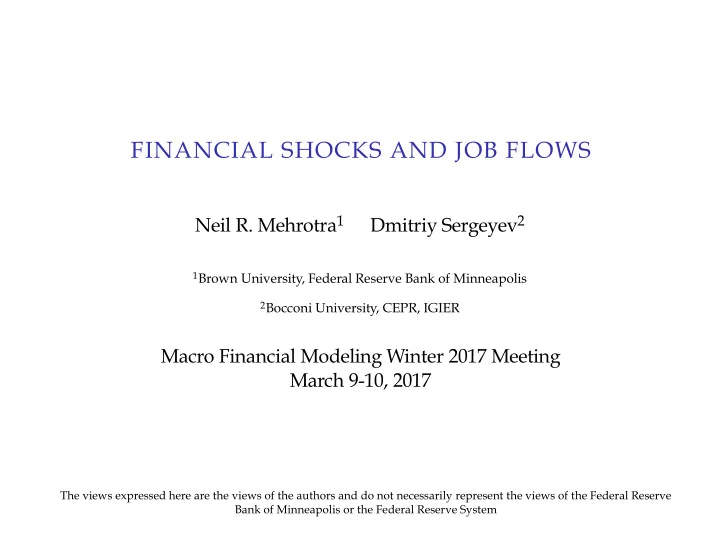

FINANCIAL SHOCKS AND JOB FLOWS Neil R. Mehrotra 1 Dmitriy Sergeyev 2 1 Brown University, Federal Reserve Bank of Minneapolis 2 Bocconi University, CEPR, IGIER Macro Financial Modeling Winter 2017 Meeting March 9-10, 2017 The views expressed here are the views of the authors and do not necessarily represent the views of the Federal Reserve Bank of Minneapolis or the Federal Reserve System
J OB F LOWS AND THE G REAT R ECESSION Source: Business Dynamic Statistics
WHAT WE DO? Model Build heterogenous firm dynamics model with financial frictions • Calibrate shocks to fit job flows in the Great Recession • ⇒ firm credit disruption explains 18% decline in employment Empirics • Estimate the effects of financial shocks on job flows ⇒ In line with theoretical model predictions
ECONOMIC ENVIRONMENT • Goods: consumption good • Assets: capital, riskless bonds • Technology: • Agents: households, intermediaries , firms
FIRMS
FIRM LIFE CYCLE
COMPARATIVE STATICS: FINANCIAL SHOCK Proposition
STATIONARY EQUILIBRIUM CALIBRATION Standard calibration 𝑠, 𝛽, 𝜀, 𝜒 are chosen to match standard moments • Parameters Firm-specific productivity 𝜗 ',( = 𝜗̅ ' 𝜗̃ ',( Distribution 𝑔 𝜗̅ ' matches size distribution of mature • firms employment in BDS, 2000-2006 𝜗̃ ',( is set to match job flows of 15% of employment • Firm exit rates 𝜏 • Approximate empirical age distribution of firms using BDS averages, 2000-2006 Financial parameter 𝜓 and initial assets 𝑏 0 • Target distribution of employment by firm age and firm size
AGGREGATE GROSS JOB FLOWS Financial Shock Productivity Shock 0 0.05 Job Destruction Job Destruction Job Creation Job Creation − 0.01 0.04 % change relative to SS % change relative to SS − 0.02 0.03 − 0.03 0.02 − 0.04 0.01 − 0.05 0 − 0.06 − 0.01 0 5 10 15 0 5 10 15 years after shock years after shock
GROSS JOB FLOWS: AGE AND SIZE EFFECTS
IMPULSE RESPONSE MATCHING AGGREGATES
IMPULSE RESPONSE MATCHING FIRM AGE CATEGORIES Employment (births) Employment (young) Employment (mature) 0 0 0.1 change from SS − 0.2 − 0.2 0 − 0.4 − 0.4 − 0.1 0 5 10 0 5 10 0 5 10 JC (births) JC (young) JC (mature) 0 0 0.5 change from SS − 0.1 − 0.2 0 − 0.2 − 0.4 − 0.5 0 5 10 0 5 10 0 5 10 years after shock JD (young) JD (mature) 0.5 0.2 change from SS Model Data (2008 − 2012) 0 0 − 0.5 − 0.2 0 5 10 0 5 10 years after shock years after shock
IMPULSE RESPONSE MATCHING FIRM SIZE CATEGORIES Employment (small) Employment (medium) Employment (large) 0.1 0 0.1 change from SS 0 − 0.1 0 − 0.1 − 0.2 − 0.1 0 5 10 0 5 10 0 5 10 JC (small) JC (medium) JC (large) 0 0.5 0 change from SS − 0.1 0 − 0.2 − 0.2 − 0.5 − 0.4 0 5 10 0 5 10 0 5 10 JD (small) JD (medium) JD (large) 0.5 0.5 0.5 change from SS 0 0 0 − 0.5 − 0.5 − 0.5 0 5 10 0 5 10 0 5 10 years after shock years after shock years after shock
EMPIRICAL STRATEGY Effect of financial shocks on job creation and destruction? 1. Financial shocks measure? • Use housing prices as proxy 2. Sufficient observations? Use MSA-level variation in job flows and housing prices • 3. Omitted variables? OLS: time fixed effects, local business cycle measure • • IV: Bartik approach 4. Parallel channels? [household demand channel] • Compare new firms vs. new establishments
JOB FLOWS • Job creation falls on impact after negative shock • The shock has a persistent effect on job creation
JOB FLOWS BY FIRM AGE Job creation by new/young firms falls the most after negative shock • • Job destruction at young firms falls after a decline in house prices
JOB FLOWS BY FIRM SIZE • Job creation falls disproportionately at medium-sized firms • Job destruction rises at small firms consistent with model predictions
CONCLUSION 1. Firm dynamics model • Use job flows to decompose sources of fall in employment in US Firm credit channel accounts for 18% of decline in employment • 2. Empirics House price changes affect job flows in line with model predictions • • Strongest effects for young and medium-sized firms • New establishments of existing firms do not significantly react to housing price changes while new firms do
Recommend
More recommend